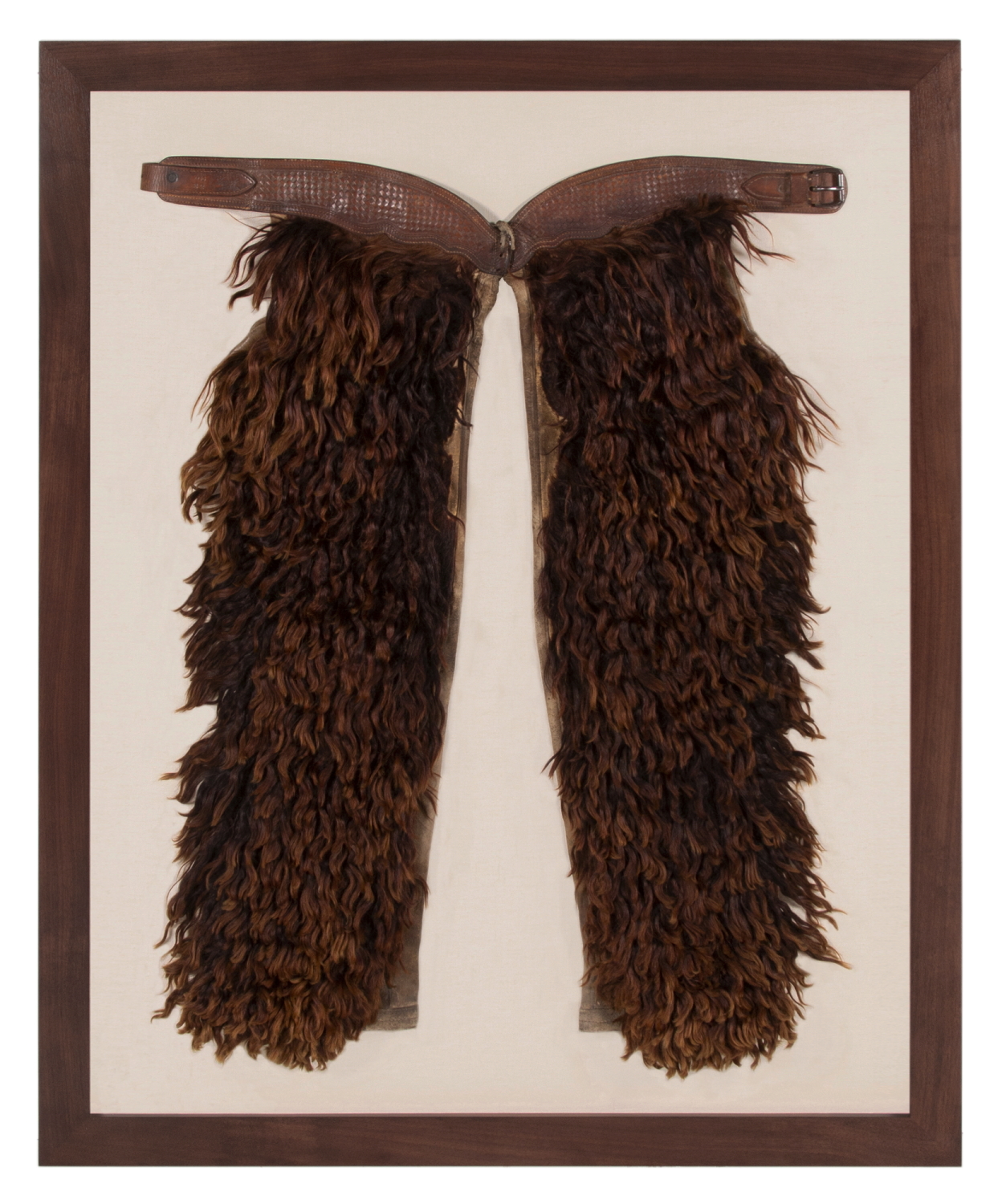
| |
WOOLY, ANGORA CHAPS WITH BEAUTIFULLY TOOLED LEATHER, MADE BY THE JOHN CLARK SADDLERY COMPANY OF PORTLAND, OREGON, SIGNED, CIRCA 1873-1929 |
| |
|
| Dimensions (inches): |
Frame - 50.75" x 40.5", Chaps - 39.5" x 30.5" |
| Description: |
|
Wooly chaps made of leather and canvas, faced with dyed Angora, made by the John F. Clark Saddlery Company (later John Clark & Son) of Portland, Oregon. The belt portion is beautifully tooled and signed. Founded by John Clark (b. June 1826, Newry, County Down, Ireland, d. June 18th, 1919) in 1873, the firm was to become one of the most prolific makers and operated for 47 years.
Biography of John Clark & His Saddlery
John Clark was born 13 June 1826, Newry, County Down, Ireland. His mother was of English origin. He learned the art of harness and saddlery in Liverpool, England at age 17. Afterward, he traveled to London and Paris as a journeyman. He arrived in Portland, Oregon, in 1862, by way of Paris, New York and San Francisco. His first job as a saddler was with pioneer maker, Samuel Sherlock.
Clark opened his own business at 130 Front Street in 1872. He was to become one of Portland’s most prolific saddlers for the next 47 years. His saddles, chaps, cuffs, rolls, bridles, and harness, as well as a line of bits and spurs, were sold locally, regionally and shipped to at least as far as Eastern Montana. In 1879-1880 he employed 8 persons.
In 1871 John Clark married Elizabeth C. Watson. His obituary states that the couple had five children: William T., who worked at the saddlery, Charlotte (Apperson) of Portland, John A. of Seattle, Edward of Los Angeles, and Roy of Portland, (US Army, WWI). Elizabeth died 18 June 1901. John married his second wife, Rachel Shaw, on the 22nd of April, 1906. She was born in Ontario, Canada, on the 16th of November, 1867 and came to Portland with her parents as a child.
The now famous Clark Bucking Roll was claimed to have been invented by John Clark, and patented on May 21st, 1901. This attachment converted the straight fork, or “A” fork saddle into a swell fork saddle that helped keep the rider in place on a rough ride or downhill gallop. Prior to this, a blanket roll or slicker was tied to the forward strings across the inside of the fork, to achieve the same results. Dave Hamley, a saddle maker from Pendleton [1969], credits John Clark with the introduction of bucking rolls. Most saddlers agree that bucking rolls set the pattern for the popular later-day swell fork saddle. Several famous saddlers from Montana claimed to be the true inventor. A long testimonial devoted to the defense of his alleged patent appears in his 1901 catalog.
In 1901, Clark’s letterhead read: “JOHN CLARK & SON, 104-106 Front St” . The header included many of the types of saddlery that they produced as well as the styles of saddle trees available. In 1914, the letterhead read, JOHN CLARK SADDLERY CO.and the byline mentioned that in addition to saddlery, the Clarks were “importers and jobbers of saddlery hardware and leather, robes, trunks, suitcases, bags, gloves, etc.” An engraving of the bucking roll was still prominent on the letterhead.
John Clark passed on then 18the of June, 1919. His obituary noted that he was to donate his land at 4th and Stark in Portland, in order that it may be used for worker housing during WWI. In 1918 John Clark was listed as President, with William F. Clark as Vice President of the firm and William Mann as Secretary. In 1920, William was listed as President, Rachel Clark as V.P., and S.E. Helliwell as Secretary. The Company remained at 104 Front St. in 1923. In this same year, Rachel was listed in the City Directory as residing at the Multnomah Hotel, while William and his wife, Margaret, claimed residence at residing at 1167 Multnomah St. In 1926, the Saddlery was still in business under William T. Clark, but E.L. [Edward?] was listed as V.P.. Not until 1928 does Rachel Clark disappear from the company roster. At this time Clark’s daughter, Charlotte, assumed the role of Secretary. In 1929 the John Clark Saddlery Company was no longer listed in the City Directories, but W.T. Clark was listed as a harness maker.
Rachel Clark died on Feb. 12th, 1933. According to her obituary, published in the Oregonian, she left an estate of $50,000, to be probated. The will was contested by Rachel’s brother, George F. Shaw, as an estate of $100,000, due to the fact that at the time of her death, there were two wills, differing in dispersion with his siblings. There is no mention of any of John Clark and Elizabeth’s sons or daughters.
Mounting: The solid walnut frame is of exceptional quality, custom made to size, dovetailed and with wafered corners. The mount was carefully stitched with wire. A deep shadowbox was constructed. The glazing is U.V. protective plexiglass.
Condition: There is some expected wear and loss from obvious use. |
|
|
| |
|
| Primary Color: |
brown |
|
| Earliest Date: |
1873 |
|
| Latest Date: |
1929 |
|
| For Sale Status: |
Sold |
|
| Price |
SOLD |
|
| E-mail: |
info@jeffbridgman.com |
|
 |
|
Page Views:... 1823 |
|


